I would consider what you are using it for...What distance are you shooting at ? 100m? 200m? 50m? I will presume for the meantime it is 100m. (ish) Even if you treated your entire number of shots one group and include your flyers, you have a group that is about 45mm wide and 30mm high. If you push that out to 300m and you have a current group of 135mm x 90mm which is still well within deer o clock.....(.Actually it is within possum o clock) so if you are hunting with it then I would carry on.
If this is not good enough, and if it was me, I would wait a few days,get some more ammo, Go out with a target and take 5 or 10 shots on paper doing my absolute best to treat every shot as my first and only shot. I would give myself time between each shot for the rifle to go back to cold. and I would NOT look where each shot went until all 10 have been fired. If you have a scope where you can se the hole after you shoot, then I would put a white dot on a black background. If you really want to see the sequence, the I would set up 10 different 'dots' and number them so you can put one hole through each.
Welcome guest, is this your first visit? Create Account now to join.
Welcome to the NZ Hunting and Shooting Forums.
Search Forums
User Tag List
+ Reply to Thread
Results 16 to 22 of 22
-
08-04-2024, 12:12 PM #16Member

- Join Date
- Nov 2014
- Location
- Christchuch New Zealand
- Posts
- 5,867
Intelligence has its limits, but it appears that Stupidity knows no bounds......
-
-
08-04-2024, 12:56 PM #17Member

- Join Date
- Dec 2011
- Location
- Southern Alps
- Posts
- 4,081
You are waisting ammo gimp lols,go hunting.
-
08-04-2024, 01:06 PM #18Member

- Join Date
- Apr 2022
- Location
- New Plymouth
- Posts
- 2,376
from your first target I would have gone one click up - so now put up a target go one click up and see what that shot is - I think the shooter went to pieces myself possibly ???so one shot - see what it does --if you can do some .22 target work first calm you down and get your eye in - I dont think this is rocket science since the first 3 were such a good group
-
11-04-2024, 10:51 AM #19
Ok you're all onto it.
This is a collection of real 3-shot groups, fired with no sight adjustments between groups. These groups were shot at 53m with a .22LR, from a bipod/rear bag in a prone position, in no-wind conditions. The actual order of groups shot varied somewhat from the order presented.
The target was overlaid precisely lined up with a backing target and replaced between each group. This is the composite group of all 40 rounds fired on that backing target. In addition to the 3-shot groups, I also fired a 5-, 10- and 4-shot group. I then ran out of that particular type of ammunition.
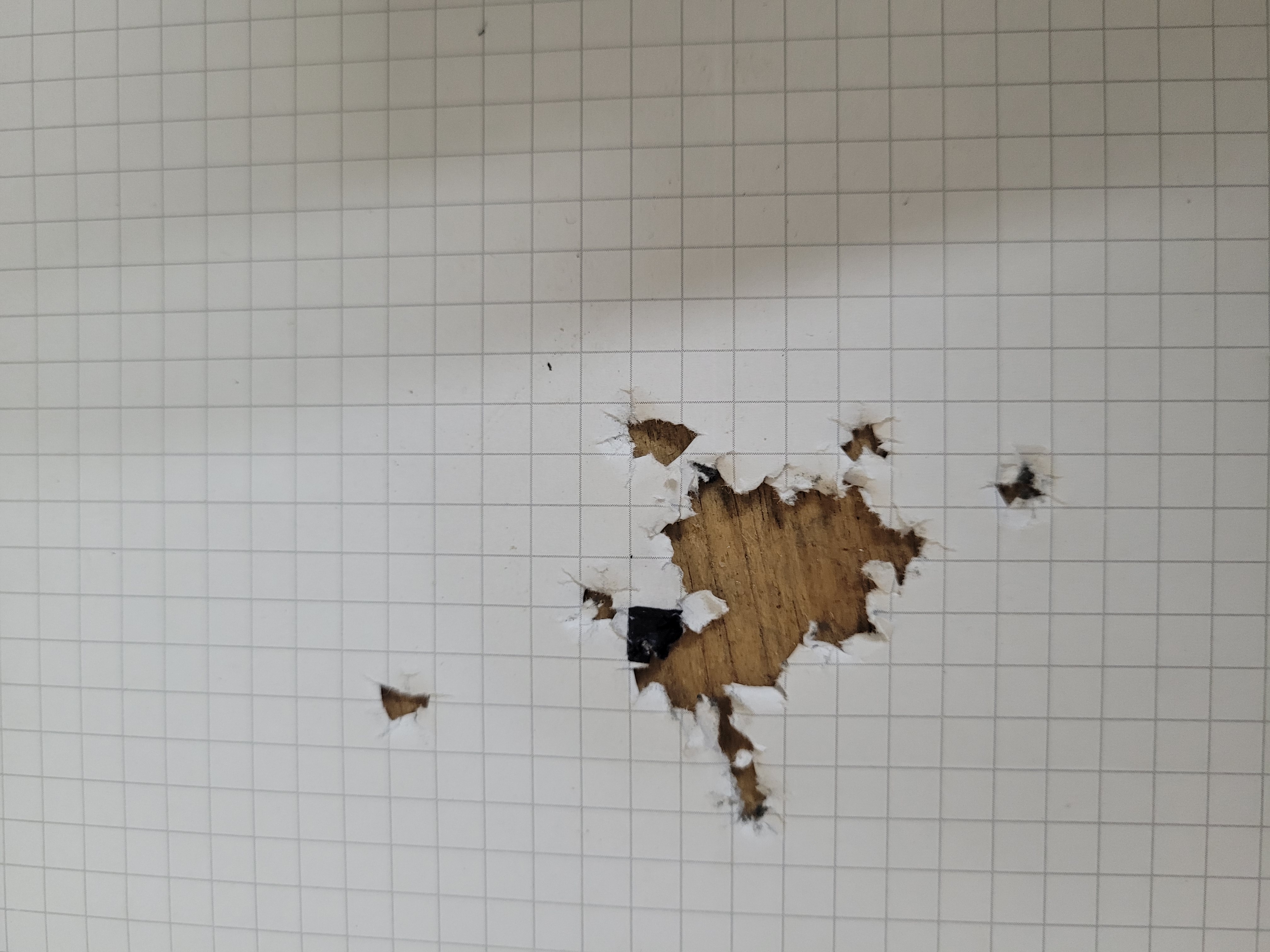
While this group was actually shot at 53m, the distribution of shots is genuine and could lead a shooter to the same conclusions at any range. It is useful to use it to simulate rounds shot at 100m with a centrefire hunting rifle.
Plotting X/Y co-ordinates vs point of aim for each shot in an excel sheet allows me to calculate the mean point of impact (MPOI) for the total group, each actual 3-shot (or other) group, or combine shots to represent a potential group from within the rifle’s total dispersion. I also calculated the radius of each shot from MPOI, and hence the mean radius of all shots and the standard deviation of these.
Before discussing the results and their significance, it is wise to start with the functional objective(s) we have in mind when we shoot groups. These generally are:
• To understand our mean point of impact so that we can align our sights (get a zero).
• To understand something of the precision capability of our rifle system (what size target can I expect this rifle to be able to hit) including the load.
Not every bullet hits the same place – there is a distribution on the target. The more data (shots) we have to plot this distribution, the more accurate an understanding of the rifle’s mean point of impact and capability we gain and the better we can predict what it will do in future.
Note that excluding the apparent outlier (“The Flier”) at top left of the overall group either via not including in the mean, or using the Median point of impact makes no real difference vs including it – as an outlier it has a small effect on the mean due to the large sample size. There is no reason to discount it from the distribution – it is a real datapoint, there was no indication that it was shooter error. It may just be an artefact of the variability that exists in .22LR ammunition. If we include the “best” shots, we have to include the “worst” shots. Even if it is “shooter error” – shooter error is a part of the system.
So what information can we get from this exercise relating to the 2 objectives for shooting groups, and how can we use it?
1. The 3 shot groups shot do not individually tell us reliably where our real MPOI is. This means that we may adjust based on a 3 shot group that lead us to zero incorrectly, or “chase our zero”.
If we simulate a series of sequential 3-shot groups using all shots in the sample (shots 1-3, 2-4, 3-5, 4-6, etc) and plot the mean point of impact of each of these, we get the following results (note that the real 3-shot groups give the same result with less resolution, however this is a valid method of artificially increasing our sample size of 3-shot groups):
• 25% of these groups represent the real MPOI accurately.
• 50% of these groups give us a 3-shot MPOI that is 0.1MIL or more away from our real MPOI in one axis (X or Y)
• 23% of these groups give us a 3-shot MPOI that is 0.1MIL or more away from our real MPOI in both axes (X and Y)
• 2% of these groups give us a 3-shot MPOI that is 0.1MIL away from our real MPOI in one axis, and 0.2MIL away in a 2nd axis.
75% of these result in us being incorrectly zeroed or chasing a wandering zero if we base our zero on isolated 3-shot groups. This manifests in reality with tedious regularity.
Some examples of these can be seen in this chart – the blue dots are all shots plotted, the Orange X is the real MPOI, the various coloured diamonds are some of the MPOI we would interpret from real 3-shot groups.
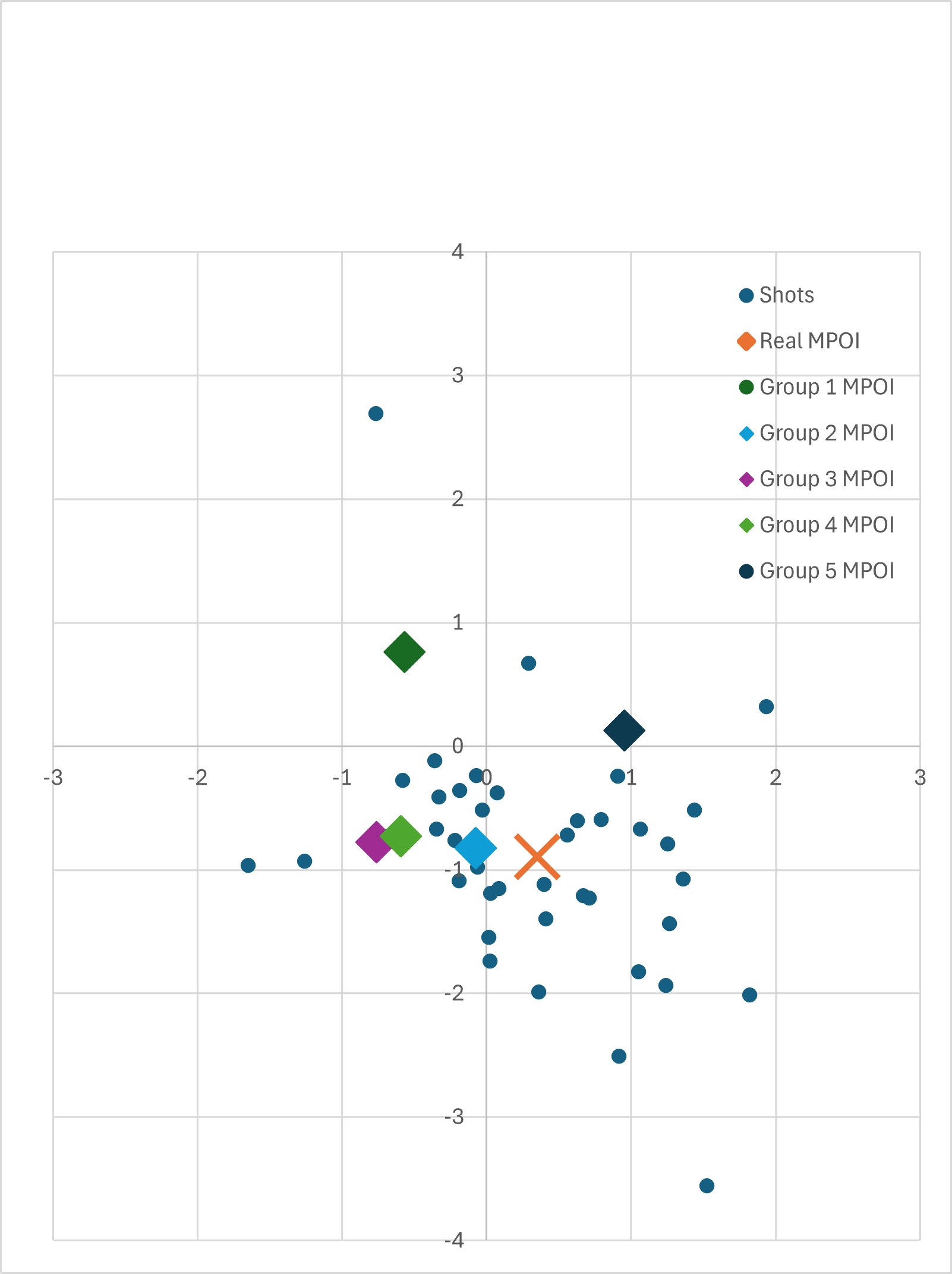
The real MPOI is 0.9 click (0.09MIL) low, and 0.4 click (0.04 MIL) right (+- 0.3 click at 95% confidence level) of point of aim. I have this MPOI to 3 decimal places of 1 click, however given the confidence intervals tell us we can only be reasonably confident that it’s within 0.3 click of that position, it is meaningless to report it at 3 decimal places.
What is the significance of this? Well, if we took the first suggestion to take 1 click up and 1 click right, we would be as well zeroed as possible for elevation, but we would be now 1.4 clicks to the right for windage. Through this process – taking an observed 3 shot MPOI that is 1 click off the real MPOI, and making a further adjustment in the wrong direction, we can easily end up well off zero.
Importantly, this is largely irrelevant for normal hunting purposes – inside 400m or so the error will be so small as to be undetectable when shooting steel or game animals.
These sorts of errors will however begin to really show up around 500-600m and further out. Errors of this nature – 0.1-0.2MIL - in elevation particularly can lead to frustration with ballistic calculators being “wrong” and attempts to “correct BC or MV”, especially in combination with other data input errors.
This is especially true when attempting to make inferences at longer ranges based on small groups at those ranges – how much confidence can you have in your MPOI at 600m based on a 3-shot group (or a single shot) at that range?
It is also entirely possible (indeed, likely something like 25% of the time) that you will luck into avoiding these problems. It is by no means certain that you’ll zero based off one of the worst-case examples.
2. The 3-shot groups do not individually or on average tell us the overall precision capability of the rifle system and can be misleading.
The smallest of 7x 3-shot groups measures 0.273”, and the largest measures 1.1”. These 7 groups average about 0.6”. This kind of variation is natural and expected with sample sizes this small.
This is not an uncommon representation of groups that a hunting rifle can be expected to produce and could lead a shooter to conclude that they have “a 0.6MOA rifle”. This can be a true statement if you are clear about what you mean – a rifle that seems to average 0.6MOA 3-shot groups.
However, this does not mean the rifle can hit a 0.6MOA target reliably even if perfectly zeroed - the individual and average group sizes are meaningless unless the actual position of all shots relative to point of aim is included – i.e. all groups are “overlaid”.
The actual extreme spread of the precision of this rifle system is closer to 2.7 inches – any 1 round fired could be within that overall dispersion. In this sense, it could be a true statement to say this is a 2.7MOA rifle.
Group size (extreme spread) is however not a particularly good tool for predicting the future. The distribution of shots within the extreme spread is not uniform. A more useful tool is the mean radius, and the standard deviation of the mean radius.
The mean radius is the average distance each shot falls from the MPOI. In this instance, it is 1.0cm (+- 0.2cm at the 95% confidence level).
The standard deviation across this sample is 0.7cm. 68% of shots will fall within 1 standard deviation of the mean radius and 95% of shots will fall within 2 standard deviations of the mean.
This result is of course irrelevant to hunting. The undoubted primary limiting factor for hitting our targets when hunting at normal ranges is shooter proficiency. A rifle that has an overall dispersion capability of 1.5 or 2.5 MOA is entirely adequate for shooting deer-sized animals reliably to 400 metres or further – indeed, many of you probably do it regularly – just unaware of the real capability of the rifle.
However, while it is irrelevant to hunting, hunters often make claims about the level of precision attained by our rifle systems based on 3-shot groups, to a level that is irrelevant to hunting.
The noisiness of this data
It is easy to say “but that’s a really poor 40-shot group and it’s from a .22, my rifle is much better than that!”, and you might be right. This is a particularly wide dispersion in comparison to our usual expectations and that perhaps makes the data particularly noisy – or perhaps means our usual expectations need to be adjusted to align more closely with reality.
Any number of hunting rifles could produce the 3-shot groups I have shown. The largest 3-shot group produced during this exercise was 1.1 inches. This would hardly ring alarm bells with most shooters.
It will be a natural reaction for readers to say “but my rifle is definitely more precise than this”.
However, without the right data, you cannot actually make this statement with confidence. I would encourage you to examine the data you have available to test your thinking.
Additional datasets
I have also generated a 2nd dataset, using 19 rounds of 69gr Match ammunition fired through a Tikka T3 .223 at 93 metres.
The results are consistent with the above, however with this rifle I used data from 3x 5-shot groups and 1x 4-shot.
Similar errors of MPOI exist with the 5-shot groups vs the real MPOI of the 19-shot composite group: in this case the plot is different - the shots have been transformed so that MPOI is 0,0 on the X/Y axes.
Using the MPOI of 2 of the 4 individual groups would give a .1MIL error in zero (the orange and purple diamonds).
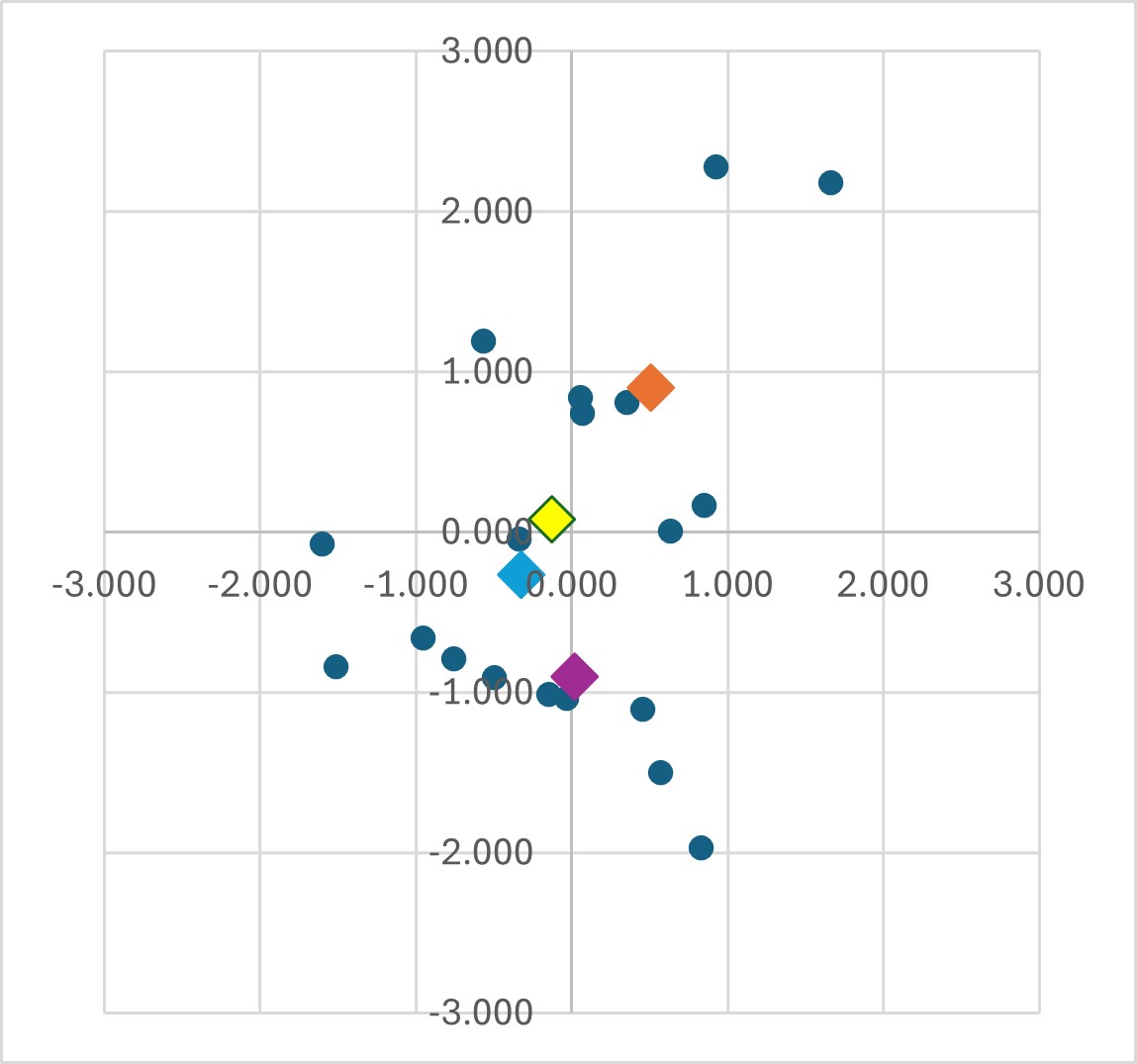
The rifle overall may be more precise c.f. my .22 groups. The average of the Tikka groups was 27.3mm, or about 1.1MOA. The overall group was about 42.5mm, or around 1.6MOA, with a mean radius of 1.3cm (+- 0.3cm at 95% confidence level) and standard deviation of 0.6cm.
This isn’t out of line for what you’d expect from an out-of-the-box hunting rifle.
This is not a new idea. Additional data on this can be seen in this long-running thread posted when I understood that 3-shot groups were not particularly useful. 12 years later however the test I proposed at the time is now not what I would suggest, with an improved understanding of the statistics.
https://www.nzhuntingandshooting.co....challenge-700/
The shift in MPOI between apparently precise groups can be seen on the targets provided by the very few people who felt sufficiently confident to accept the challenge and post their results. Even with apparently extremely precise rifles this shift is visible, as well as the apparent “flier” which seems to fall within the actual distribution when the shot positions are taken in aggregate.
e.g.
I will also be continuing to plot data on my rifles in this format in the future.
So what are some actionable takeaways?
• It probably doesn’t matter for hunting.
• You could record data from several groups of whatever size over time and overlay the shots to get a better understanding of your MPOI for a more accurate zero
• Don’t ascribe too much importance or truth to 3-shot group sizes
• A substantially more precise rifle system will experience these problems to a much lesser degree. The real MPOI shift inside a real 1MOA distribution will cause less significant error than the shift in a real 2.5MOA distribution. However, how do you know if you have a more precise rifle? 3 shot groups may not reliably tell you unless you plot shot position and aggregate across multiple groups
• Start with the best quality ammunition or reloading components, and a genuinely high quality rifle system (e.g. a good cut-rifled custom barrel) and you’ll have the best chance getting good results.
-
11-04-2024, 11:12 AM #20Member

- Join Date
- Jun 2013
- Location
- BOP
- Posts
- 946
@gimp great post, you got some time on your hands at the moment?
The hornady podcast has some interesting discussions around groups and system precision. Mean radius (average miss distance!) is an useful tool, from memory Hornady said it usually settled after about 10shots, and was pretty solid after 30. Better way of measuring your rifles precision.
Really enjoying these type of posts
-
14-04-2024, 05:04 PM #21
What does this look like with a substantially more mechanically precise rifle?
I went and fired 20 rounds this morning from the Model 7 .223 w/bartlein barrel. Load was a fairly randomly selected 80gr Targex, CCI450, Ammo Inc 1x fired brass, 24.1gr 2206H, about .015" off the lands. More on this load selection at a later date.
Range 100m precisely.
Group 1
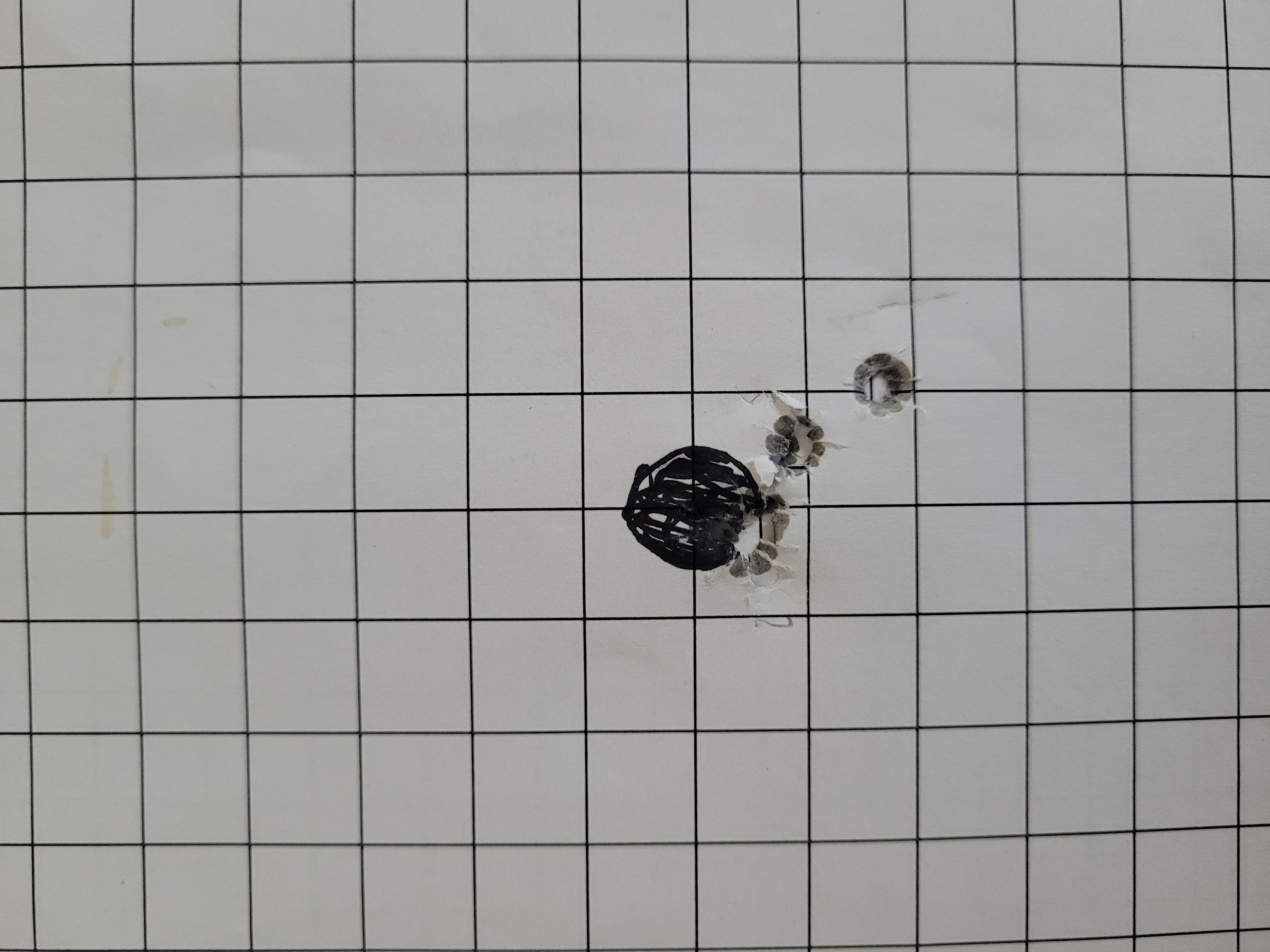
Group 2
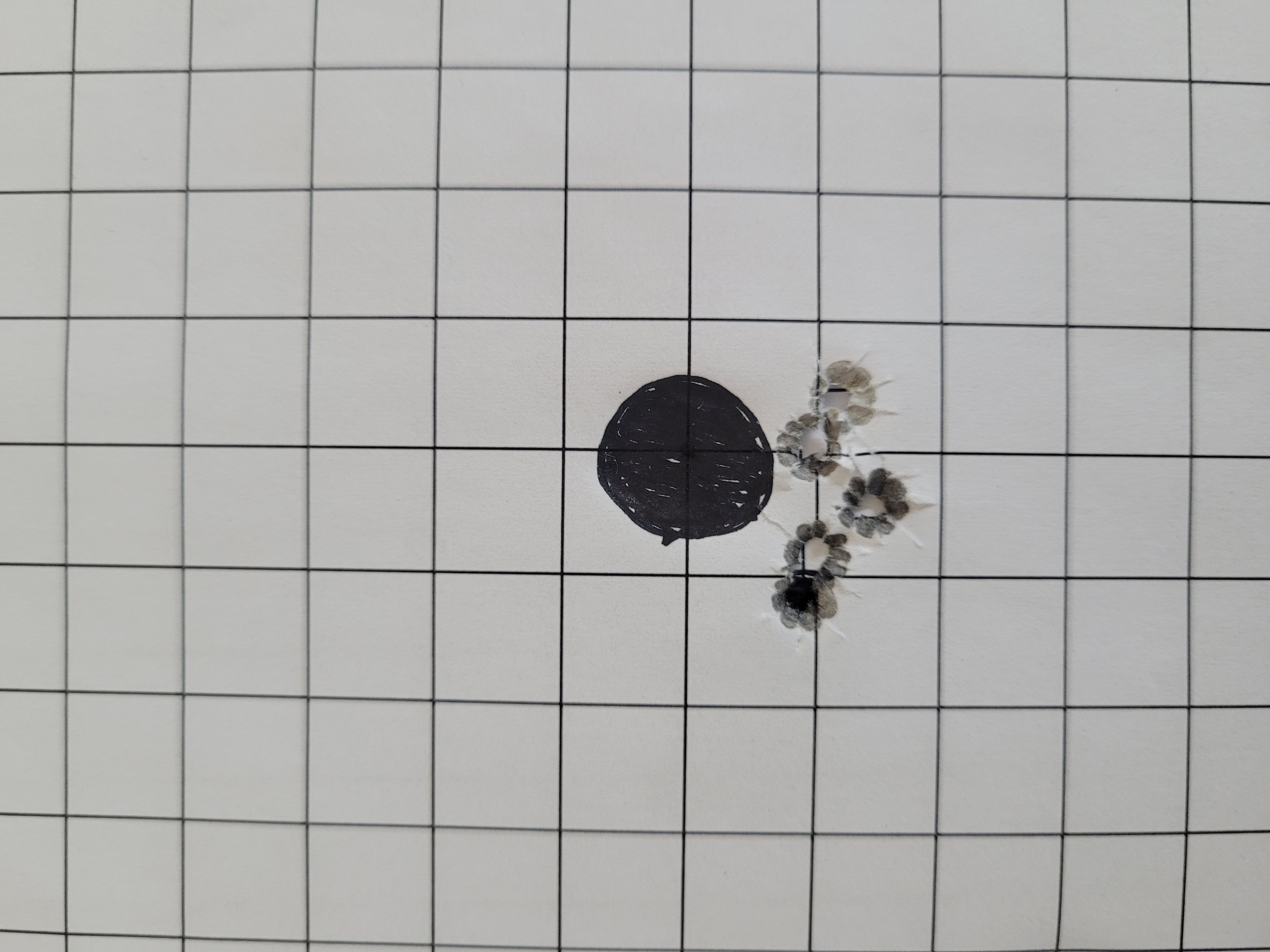
Group 3
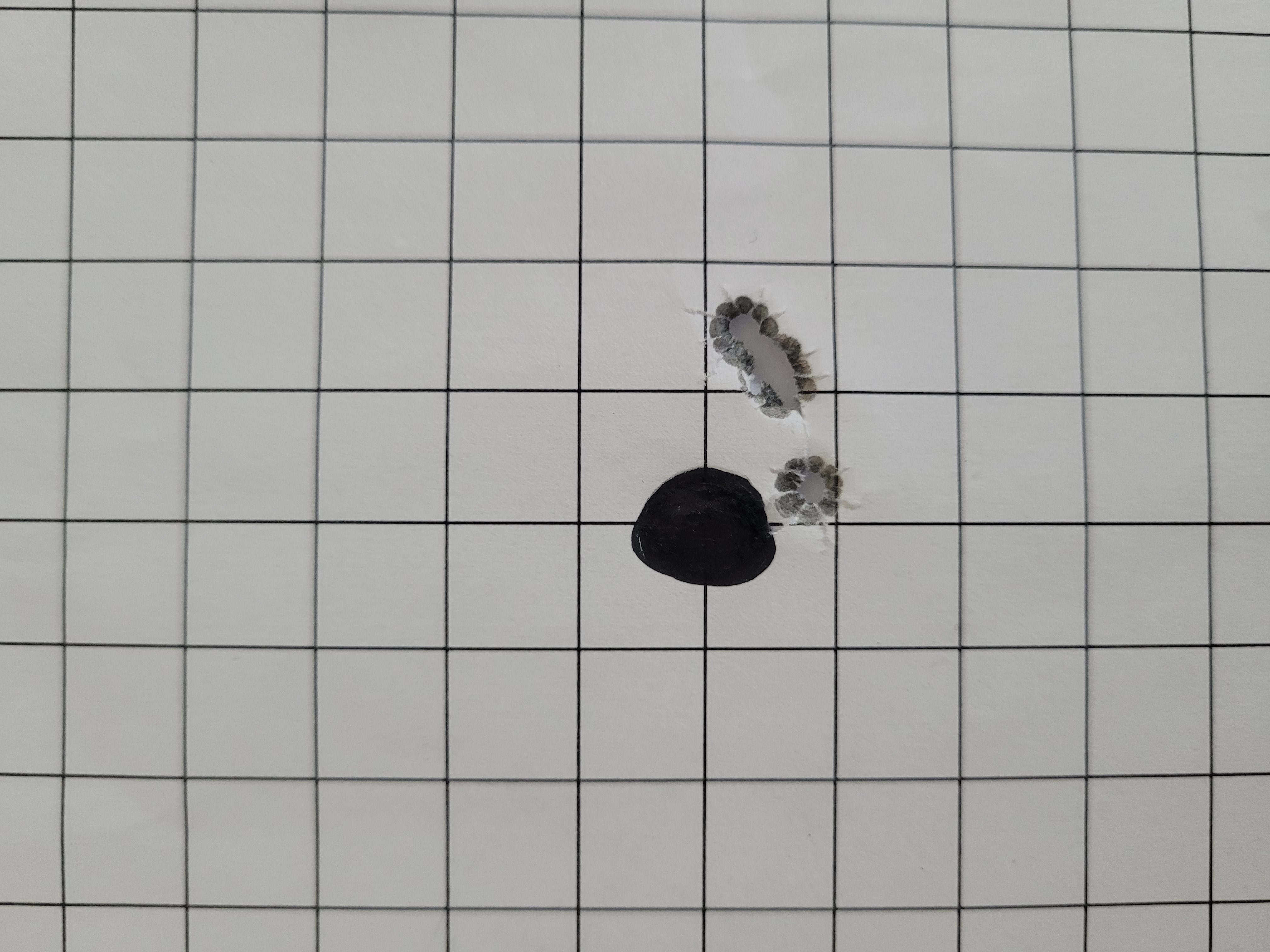
Group 4
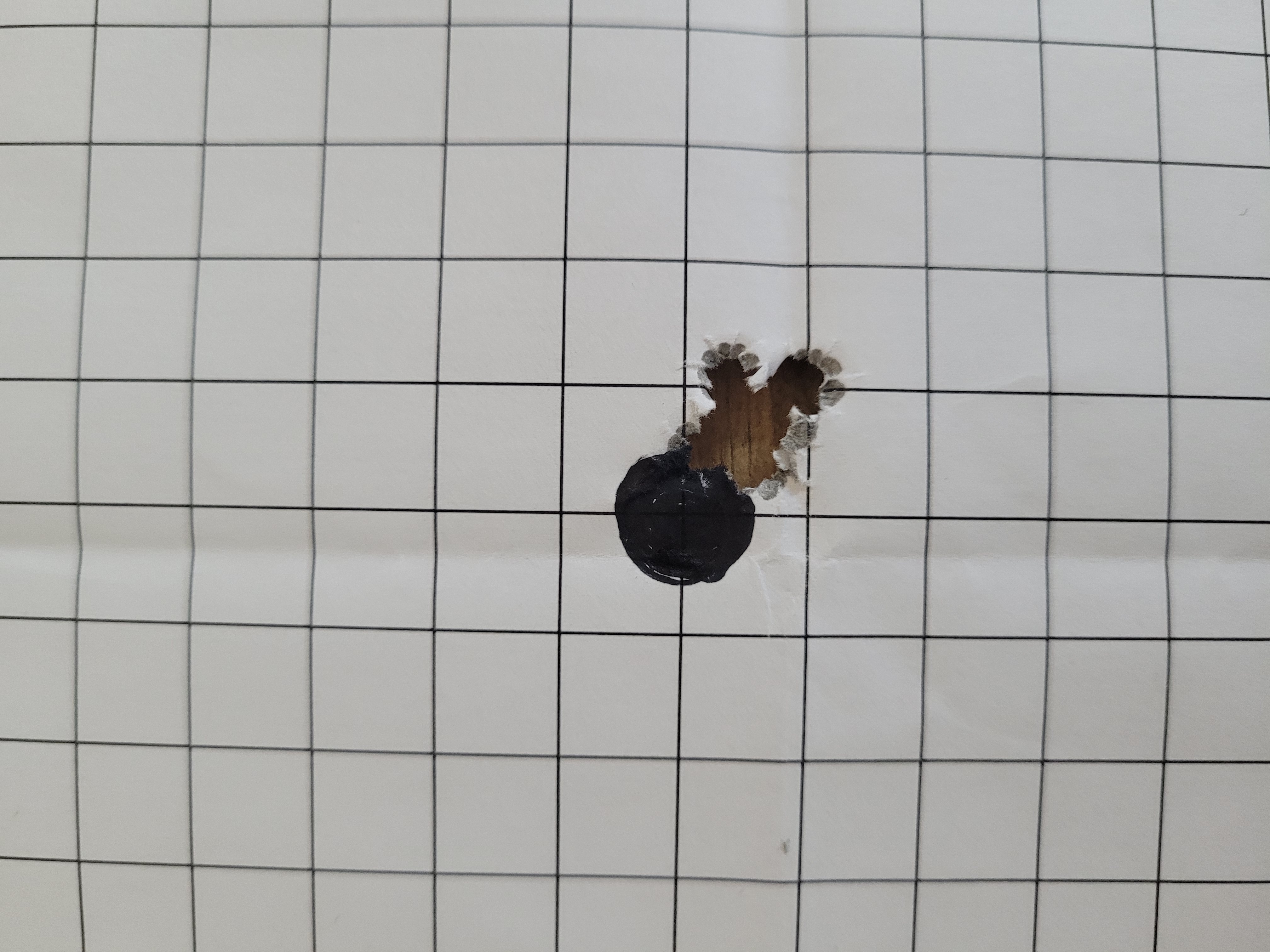
The aggregate 20 round group
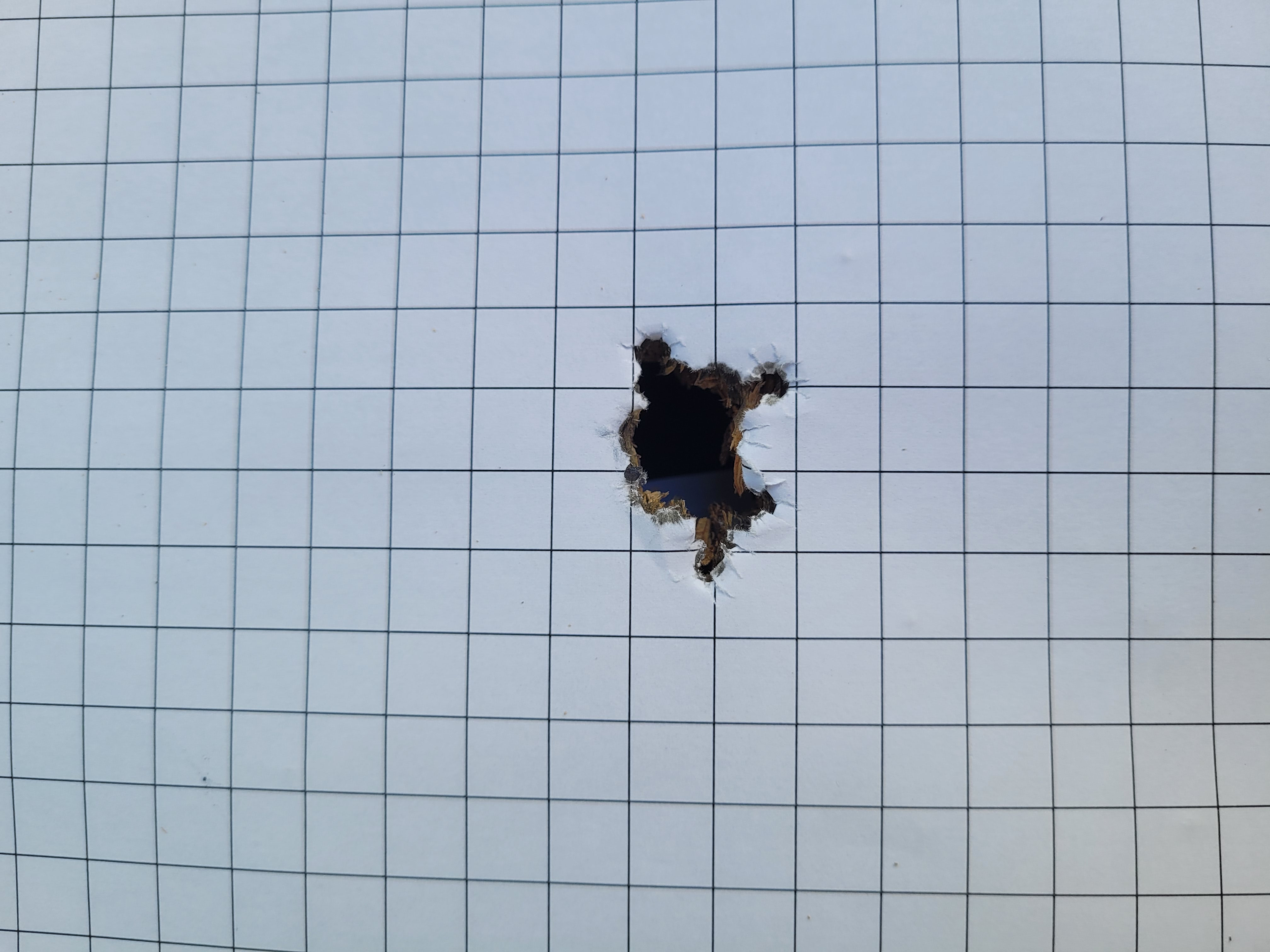
The results?
The extreme spread of the 20rd group (100m) is 2.7cm, so about .9MOA.
The mean radius is .7cm (+- .2cm at 95% confidence level) with a SD of 4cm
The mean 5-shot group size is 1.4cm or a little under .5MOA. The largest was about .7MOA, and the smallest was about .3 MOA. I'd be comfortable to say that this rifle system with me shooting it has a precision capability of 1MOA.
The MPOI of each of the 4 groups is shown here, with the shots transformed to be centred on the real MPOI. 2 of the 4 groups give a zero error of 1cm or 1 click.
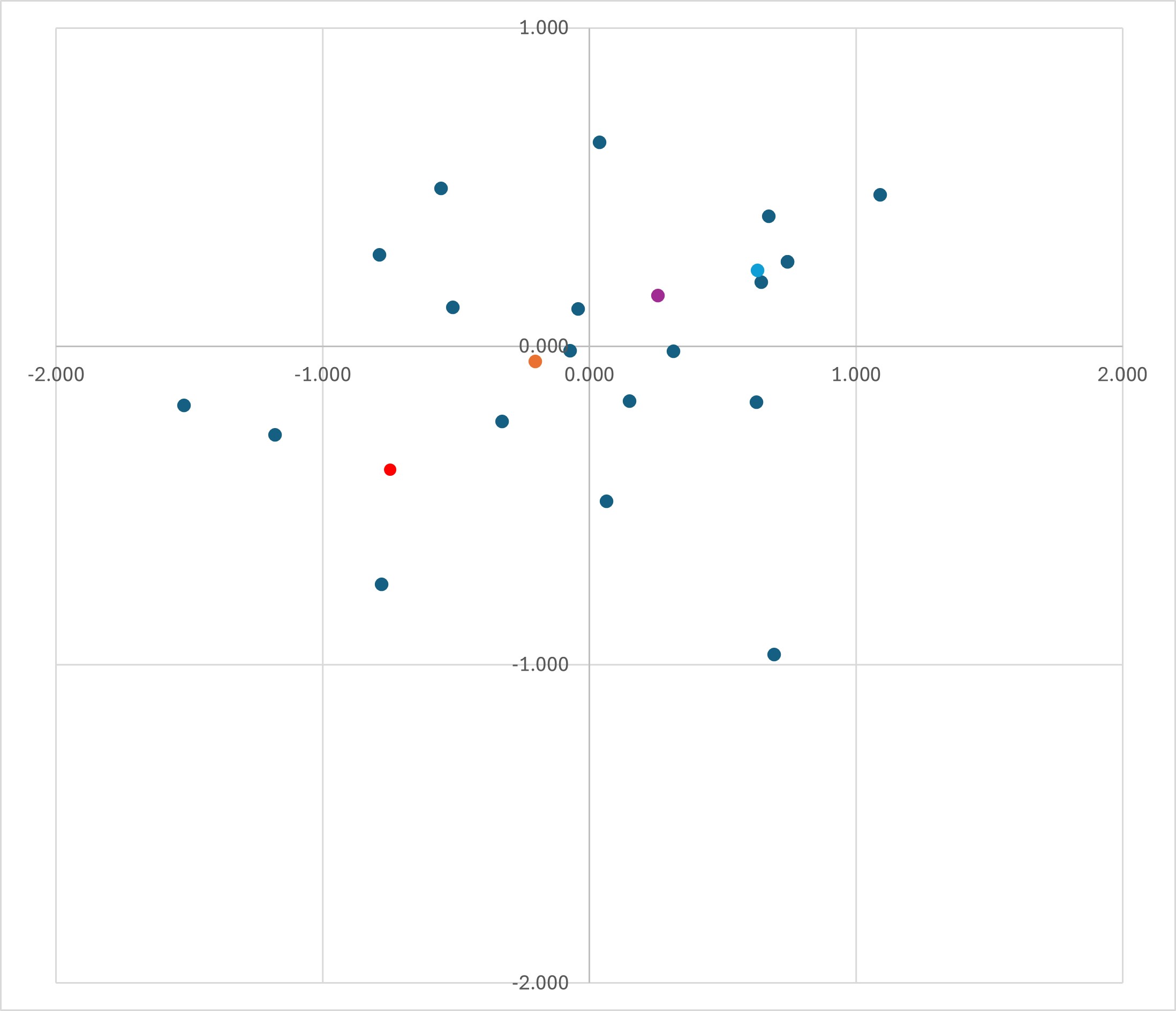
-
14-04-2024, 06:35 PM #22Member

- Join Date
- Jun 2014
- Location
- CNI
- Posts
- 5,789
Fair work there .r Gimp. Then there are the powder temp and case capacity and neck tensuon variables llus letoff errors and maybe .irage etc. The famous enclosed warehouse tests tried to eliminate these othere variables.
In my own case the biggest problem would be my own muscular control, including such things as clothing and light. In short, the errors compund above the rifle variable you have pointed out, especially at any range over 200m.Summer grass
Of stalwart warriors splendid dreams
the aftermath.
Matsuo Basho.
Similar Threads
-
Accuracy at 100 vs 600 (example). Variations in accuracy at different ranges
By stagstalker in forum ShootingReplies: 56Last Post: 24-11-2020, 10:35 AM -
Serbian 222 zeroing.
By Trout in forum ShootingReplies: 8Last Post: 24-07-2020, 04:29 PM
Tags for this Thread
Welcome to NZ Hunting and Shooting Forums! We see you're new here, or arn't logged in. Create an account, and Login for full access including our FREE BUY and SELL section Register NOW!!





 25Likes
25Likes LinkBack URL
LinkBack URL About LinkBacks
About LinkBacks



 Reply With Quote
Reply With Quote



Bookmarks